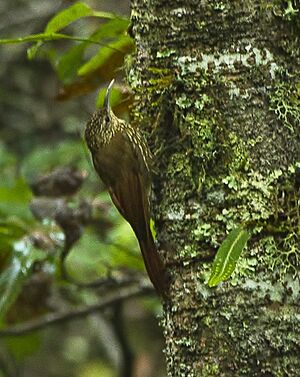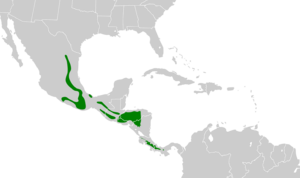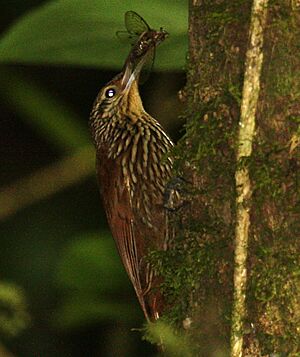Spot-crowned woodcreeper facts for kids
Quick facts for kids Spot-crowned woodcreeper |
|
|---|---|
 |
|
| Conservation status | |
| Scientific classification | |
| Genus: |
Lepidocolaptes
|
| Species: |
affinis
|
 |
|
The spot-crowned woodcreeper (Lepidocolaptes affinis) is a type of passerine bird. It belongs to the ovenbird family called Furnariidae. You can find this bird in Middle America, from Mexico all the way to Panama.
Contents
About the Spot-Crowned Woodcreeper
Different Types of Woodcreepers
Scientists group animals together based on how they are related. The spot-crowned woodcreeper used to be considered the same as the montane woodcreeper. However, in the early 2000s, scientists decided they were different species.
There are three main types, or subspecies, of the spot-crowned woodcreeper:
- L. a. lignicida
- L. a. affinis
- L. a. neglectus
Some bird experts think that L. a. neglectus should be its own separate species. They call it the southern spot-crowned woodcreeper. The other two types, L. a. affinis and L. a. lignicida, they call the northern spot-crowned woodcreeper. For this article, we will consider it one species with three subspecies.
What Does the Spot-Crowned Woodcreeper Look Like?
The spot-crowned woodcreeper is a slim, medium-sized bird. It is about 19 to 22 cm (7.5 to 8.7 in) long. It weighs between 28 to 38 g (0.99 to 1.3 oz). Both male and female birds look the same.
This bird has a thin, slightly curved beak. Its face and neck sides are dark. It has a black stripe near its cheek. The top of its head and the back of its neck are dark brown. These areas have clear, light-colored spots or diamond shapes. These spots can sometimes extend onto its upper back.
Its back and wing feathers are plain brown. Its rump (the area above its tail) is a reddish-brown color. Its wings and tail are a reddish-chestnut color. The flight feathers have brown edges. The tips of its main flight feathers are dark.
The bird's belly is olive-brown. It has wide, light-colored streaks with black edges. These streaks start on its throat and become lighter on its sides. The feathers under its wings are a yellowish-brown. Its eyes are dark brown. Its legs and feet are gray to dull green. Its beak can be bluish-pink, pale gray, yellowish, or dark brown. The base of the beak is often darker, and the tip is usually a pale, shiny horn color.
Young spot-crowned woodcreepers are darker than adults. Their crown spots are less clear. The streaks on their belly are not as sharp. Their beak is shorter and darker.
Differences in Subspecies
The L. a. lignicida subspecies looks similar to the main type. However, it is much paler overall. The L. a. neglectus subspecies is browner, not as olive. It has a deeper yellow throat. Its streaks on the belly are wider and paler, almost white.
The spot-crowned woodcreeper looks a lot like the streak-headed woodcreeper. But you can tell them apart by the spots on its head, which are not streaks. Also, their living areas usually do not overlap much.
Where Do Spot-Crowned Woodcreepers Live?
The spot-crowned woodcreeper does not live in one continuous area. The L. a. lignicida subspecies lives the furthest north. You can find it in northeastern Mexico. The main subspecies, L. a. affinis, lives from southern Mexico down through Guatemala, Honduras, El Salvador, and into Nicaragua. It does not live in Belize. The L. a. neglectus subspecies lives in Costa Rica and western Panama.
These birds live in both wet and dry forests. They mostly prefer highland areas. This includes humid evergreen mountain forests and cloudforests. They also live in drier forests with deciduous trees, oak, pine, and pine-oak trees. They are found inside untouched forests. However, they seem to be more common at the edges of these forests. They also live in older, regrown forests. You might also see them in tree plantations. They can even be found in clearings and pastures that have trees.
They usually live at elevations between 1,000 and 3,500 m (3,300 and 11,500 ft). Sometimes, during the non-breeding season, they go as low as 400 m (1,300 ft). In Costa Rica, they rarely live below 1,500 m (4,900 ft).
Spot-Crowned Woodcreeper Behavior
Movement and Migration
Most spot-crowned woodcreepers stay in the same area all year round. They are called "residents." However, some birds might move to lower elevations after the time when they raise their young.
What Do They Eat?
The spot-crowned woodcreeper mostly eats arthropods. These are creatures like insects and spiders. Beetles and their egg cases seem to be a big part of their diet. They usually look for food alone or in pairs. They often join groups of different bird species that are feeding together. Sometimes, they even follow swarms of army ants.
They move up tree trunks and branches, often in a spiral pattern. They usually search for food from the middle of the forest up to the treetops. They catch a lot of their prey from plants that grow on other plants, called epiphytes. They also pick prey off surfaces. They poke into cracks in the bark and moss to find food. Sometimes, they even peel off bark to get to their prey.
Reproduction and Life Cycle
The spot-crowned woodcreeper lays its eggs between March and June. This happens across all the areas where it lives. It builds its nest in a hole in a tree or a tree stump. This hole can be natural, or it might have been made by a woodpecker or a barbet. The nest is usually within 9 m (30 ft) of the ground. Both parents line the hole with pieces of bark.
They usually lay two eggs, but sometimes three. The eggs hatch after about 17 days. The young birds are ready to fly after about 19 days. Both parents take turns sitting on the eggs. They also both bring food to the baby birds in the nest.
What Do They Sound Like?
The songs of the two northern subspecies of the spot-crowned woodcreeper are different from the southern subspecies. The "northern" song is a high-pitched sound. It usually has three notes, like "tseeu-tsee-tsee." These birds also make shorter "tseeuee" and "tseeu" calls.
The southern subspecies, L. a. neglectus, sings a long, nasal note. This is followed by a fast trill of about 20 to 30 notes. The trill goes slightly up and down in pitch, like "teeeu-titititititititititititititi." Its call is "teeeu." Both groups of birds sing mostly at dawn and dusk.
Conservation Status
The IUCN (International Union for Conservation of Nature) looks at the "northern" and "southern" spot-crowned woodcreepers separately. Both are listed as being of "Least Concern." This means they are not currently in danger of disappearing.
The "northern" type lives in a very large area. We don't know exactly how many there are, but their numbers seem to be going down. The "southern" type lives in a smaller area. Its population size is also unknown, but it seems to be stable. No immediate threats have been found for either type.
Even though this bird needs at least some forest areas nearby, it does not seem to rely on continuous forest as much as other woodcreepers. Because of this, it is thought to be only moderately affected by human activities.



